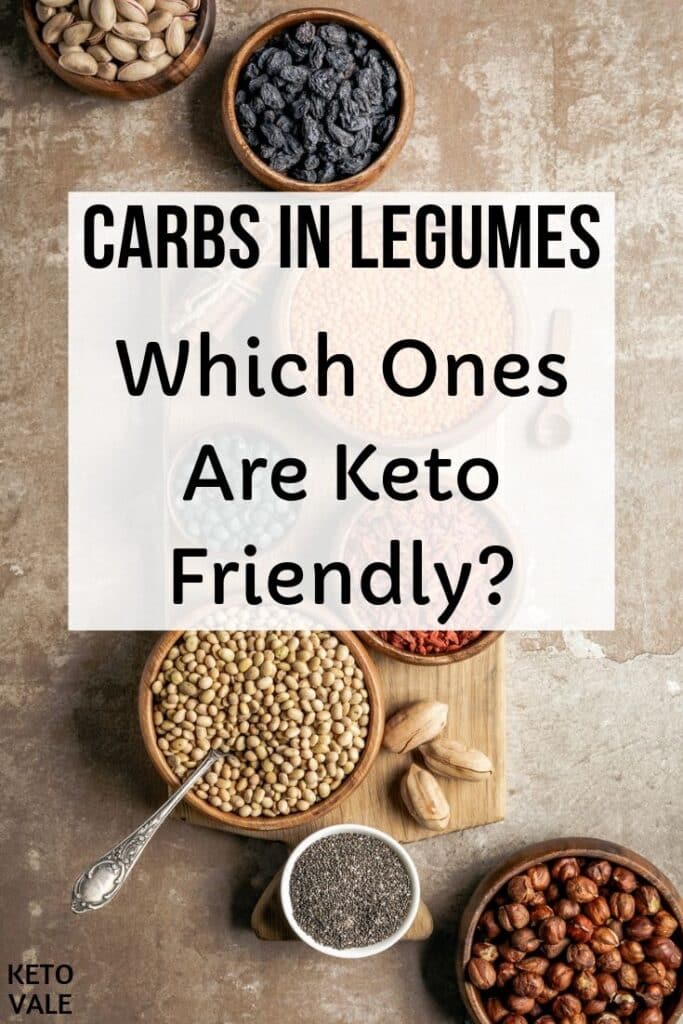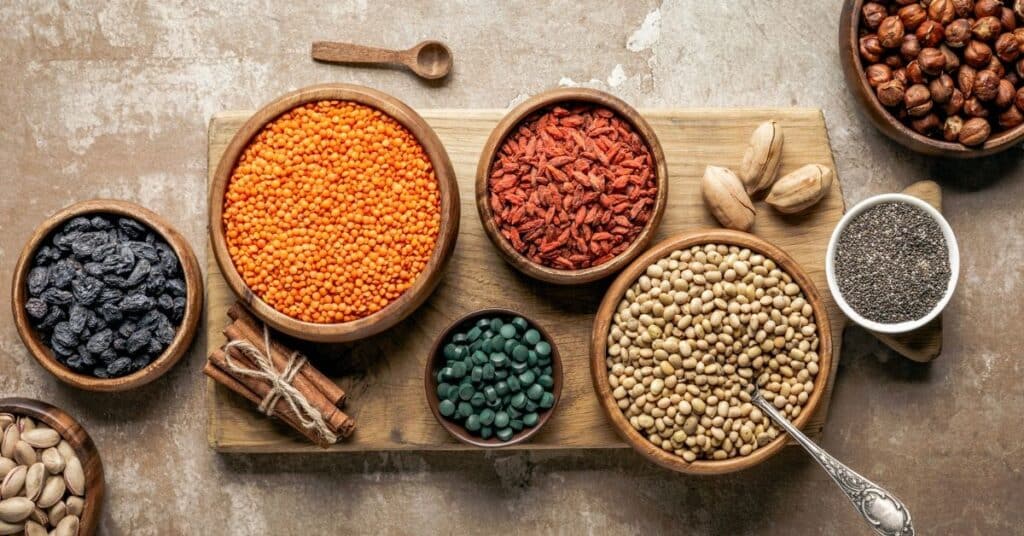Beans and peas fall into a category of food known as a legume. Traditionally, legumes are very starchy and contain mostly carbohydrates. For this reason, they are not recommended on a low-carb diet.
However, beans and peas have numerous health benefits that many health experts will tell you are worth indulging in. They’re loaded with protein, fiber, and antioxidants that you don’t normally get on a low-carb plan.
We’ve provided a list of the most common beans (and peas) and ranked them from lowest carbs per 100-gram serving to highest.
Here is everything you need to know about eating beans and peas on the ketogenic diet!
What Are Legumes?
Legumes are edible seeds that come in the form of pods. They are also known as pulses. Common types of legumes include beans, peas, chickpeas, lentils, and peanuts.
Legumes are often referred to as one of the healthiest foods on Earth. They’re not very common among Westernized societies, but they are very popular in Middle Eastern countries.
They’re a great source of plant-based protein, fiber, antioxidants, and vitamins and minerals, including B vitamins, iron, copper, magnesium, zinc, manganese, and phosphorous.
They’re also low glycemic with a glycemic index that ranges from 10 to 40. This means that legumes have a minimal impact on your blood sugar, thanks to all the fiber they have.
Research shows that legumes have the following health benefits (1, 2, 3):
- Reduces the risk of type 2 diabetes
- Lowers cholesterol
- Reduces blood pressure
- Helps control weight and improves obesity
- Reduces the risk of certain cancers
- Reduces the risk of cardiovascular disease
- Reduces the risk of overall mortality
The problem with legumes is that they are made up of mostly carbohydrates. They have very little fat and are a good source of protein.
These numbers vary depending on the type of bean or legume. Generally, all legumes should be avoided on the keto diet, but some contain more carbs than others.
Carbs in Common Legumes
Here is a breakdown of some of the most common types of legumes and their net carbs per 100-gram serving, listed in order from the lowest net carbs to the highest (4):
- Green Beans: 7.1 grams carbs – 3.4 grams fiber = 3.7 grams net carbs
- Snow pea: 7.5 grams carbs – 2.6 grams fiber = 4.9 grams net carbs
- Green Peas: 15.6 grams carbs – 5.5 grams fiber = 10.1 grams net carbs
- Lentils: 20.1 grams carbs – 7.9 grams fiber = 12.2 grams net carbs
- Peanuts: 21.5 grams carbs – 8 grams fiber = 13.5 grams net carbs
- Lima Beans: 20.9 grams carbs – 7 grams fiber = 13.9 grams net carbs
- Black Eyed Peas (Cowpeas): 20.8 grams – 6.5 grams fiber = 14.3 grams net carbs
- Fava Beans: 19.7 grams carbs – 5.4 grams fiber = 14.3 grams net carbs
- Black Beans: 23.7 grams carbs – 8.7 grams fiber = 15 grams net carbs
- Navy Beans: 26.3 grams carbs – 10.5 grams fiber = 15.8 grams net carbs
- Kidney Beans: 22.8 grams carbs – 6.4 grams fiber = 16.4 grams net carbs
- Pinto Beans: 26.2 grams carbs – 9 grams fiber = 17.2 grams net carbs
- Cannellini Beans: 25.1 grams carbs – 6.3 grams fiber = 18.8 grams net carbs
- Garbanzo Beans (Chickpeas): 27.4 grams carbs – 7.6 grams fiber = 19.8 grams net carbs
- Soybeans: 30.2 grams carbs – 9.3 grams fiber = 20.9 grams net carbs
- Anasazi Beans: 60 grams carbs – 14.3 grams fiber = 45.7 grams net carbs
- Adzuki Beans: 62.9 grams carbs – 12.7 grams fiber = 50.2 grams net carbs
Are Beans Keto-Friendly?
As you can see, the majority of most common types of beans contains 14-15 grams of net carbs per serving. Net carbs are the type of carbs that have the most influence over your blood sugar and insulin levels. Eating too many of these are not recommended on this diet.
With numbers like these, it’s important to realize that legumes and beans are not keto-friendly foods.
The only possible exception to this rule is green beans, which contain 3.7 grams of net carbs per serving.
If you keep your portion sizes down, you can enjoy green beans on a low-carb diet in moderation. If you’re strict keto, then all legumes, including beans, peanuts and lentils are off-limits.
One of the reasons why many people avoid beans and peas is because they are hard to digest. Some legumes contain compounds known as anti-nutrients that attach to your digestive tract and inhibit the absorption of some minerals. Some nuts and whole grains have these, too.
You can deactivate these compounds by soaking them in water overnight before cooking them, or you can avoid eating them all together. We recommend eliminating these foods from your diet entirely, especially if you have digestive troubles.
Keep in mind that there are more nutritious vegetables available that you can eat on a low-carb diet instead. We recommend eating green, leafy vegetables such as kale and spinach instead of green beans or legumes. These vegetables are lower in calories and carbs but they still provide a great deal of antioxidants, fiber, and nutrients per serving.
What Can You Replace Beans For On The Keto Diet?
You may have to get creative if you want to replace beans and legumes on a keto diet. Perhaps the best replacement for legumes is mixed nuts and other low-carb green vegetables.
Nuts contain similar benefits as legumes. They are high in fiber, vitamins and minerals, and protein. Plus, they are much lower in carbs and contain healthy fat.
You can replace nuts for beans in just about any recipe. They go great with other plant-based meals, or you can use them with meat dishes, too. You can even soak them, roast them or cook them like legumes.
Here are some ideas to help give you some low-carb options:
- Use Macadamia nuts, Brazil nuts, almonds, pecans, and cashews in place of peanuts and beans
- Try making a homemade low-carb vegetable soup instead of lentil soup (try this creamy pumpkin broccoli zucchini soup recipe here)
- Dip your favorite low-carb veggies in guacamole instead of hummus
- Make a roasted vegetable salad instead of bean salad for a side dish (check this recipe here)
- Use collagen powder instead of pea protein powder in smoothies and baked goods
- Swap out bean paste for tahini or tomato paste in recipes
- Top salads with black olives instead of black beans
- Use green beans in moderation in place of all beans in recipes (try this sauteed sausage with green beans recipe here)
- Use mushrooms in place of beans in your favorite recipes
Conclusion
Beans and peas are full of healthy fiber, protein and antioxidants to keep you healthy, but they are not a low-carb food! For this reason, you’ll need to avoid eating beans, peas and other legumes on the ketogenic diet.
Green beans are the only exception to the rule because they contain fewer than 4 grams of net carbs per serving. However, if you’re strict keto, then we recommend eating other low-carb vegetables that are just as nutritious with fewer carbs, such as spinach or kale.
Research shows that legumes have heart-healthy properties, due to their high fiber and antioxidant content. They have also been shown to reduce the risk of type 2 diabetes and other chronic conditions.
However, in addition to providing too many carbs, legumes contain hard to digest anti-nutrients that inhibit the absorption of minerals in the gut. You can work around this by soaking your legumes to deactivate these compounds before you eat them, but we recommend eliminating these foods from your diet entirely.
You can replace legumes with mixed nuts in most recipes. We also recommend using guacamole in place of hummus to dip your low-carb veggies in, and enjoy some low-carb vegetable soup in place of lentil soup.

Photo credit: AntonMatyukha/Depositphotos.com







